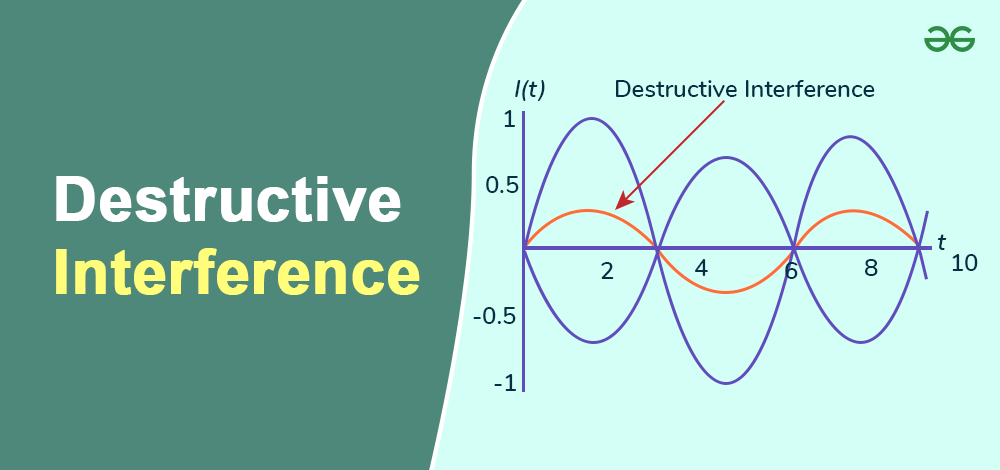
|
|
Destructive Interference occurs when two waves of the same frequency meet and overlap in a way that causes their amplitudes to cancel each other out, resulting in a wave with zero amplitude at specific points. Interference occurs when two waves meet. This phenomenon includes superimposing the waves into a wave that can either be bigger, smaller, or the same magnitude. Wave interference can be categorized into two different types i.e., Constructive and Destructive Interference. In this article, we will discuss the nature of interference and describe destructive interference.
Table of Content What is Destructive Interference?Destructive interference is a type of interference that happens when two waves with opposite displacements meet anywhere along the medium. When amplitude of these two waves is equal to 180°, destructive interference occurs. In this way, a positive displacement of one wave is compensated for a negative displacement of another wave. This yields a null wave where the amplitude is zero, and dark areas appear when waves interact destructively. Definition of Destructive Interference
Similarly when the first wave is in a position and the second wave is in a position their combined value also becomes zero. In fact at every point where they meet these two waves completely nullify each other’s effect resulting in no remaining wave. This characteristic of waves is truly remarkable. It’s worth noting that the sum of two waves can be lower than either wave or even become zero. This phenomenon is known as destructive interference. Principles of Wave InterferenceInterference works on the principle of superposition. Superposition principle states that the resultant displacement of a point due to multiple waves is the sum of the displacements caused by each individual wave at that point. In simpler terms, when two waves meet, their effects add up or subtract depending on their alignment. In simple words, superposition principle states that when two waves meet, they interact and produce a new wave. When the waves are in phase, meaning that their peaks and troughs coincide exactly with each other they will form a big wave of amplitude. But if the waves are out of phase meaning their peaks and troughs do not coincide, they will cancel each other out by subtracting amplitudes from one another creating a wave with lower amplitude. Read More about Superpostion of Wave. Destructive Interference in WavesDestructive interference happens when waves intersect and essentially nullify each other. This happens where peaks and troughs of two separate waves coincide such that they partially tend to neutralize their intensity or amplitudes. It can be demonstrated as different types of waves, such as electromagnetic waves (lighting) and water waves. Conditions for Destructive InterferenceCertain conditions must be met for interference to take place.
Mathematical RepresentationFor any two waves of the same frequency, their combined displacement at a point can be described using the principle of superposition:
Where,
If both waves are sinusoidal, we can express them as:
Where,
Destructive interference happens when the waves are out of phase by 180 degrees (π radians). This means: φ2 – φ1 = π Substituting into the combined displacement equation: y(t) = A1 sin(ωt + φ1) + A2 sin(ωt + φ1 + π) Using the trigonometric identity sin(α + π) = -sin(α), we get: y(t) = A1 sin(ωt + φ1) – A2 sin(ωt + φ1) Now, the terms with ωt and φ1 cancel out, and we see that the combined displacement depends on the difference in amplitudes: y(t) = (A1 – A2) sin(ωt + φ1)
Read More, Examples of Destructive InterferenceFollowing are some examples of destructive interference:
Destructive vs Constructive InterferenceCommon differences between both destructive and constructive interference are:
Real-World ExamplesHere are some real-world examples of destructive interference:
Applications of Destructive InterferenceDestructive interference occurs when waves superpose constructively and partially cancel each other. It has applications in:
These applications demonstrate the significance and versatility of destructive interference, in scientific and technological fields. Read More, Frequently Asked Questions on Desctructive InterferenceWhat is Desctructive Interference of Light?
What are Some Examples of Desctructive Interference?
Write Condition for Desctructive Interference.
What is the Formula for Phase Difference in Desctructive Interference?
What is Principle of Superposition?
What is the Difference Between Desctructive and Constructive Interference?
|
Reffered: https://www.geeksforgeeks.org
| Class 12 |
Type: | Geek |
Category: | Coding |
Sub Category: | Tutorial |
Uploaded by: | Admin |
Views: | 14 |